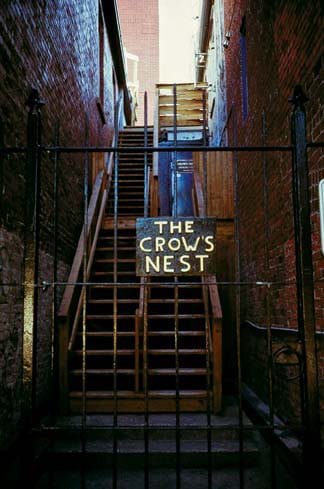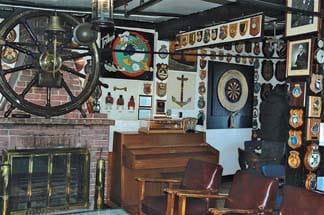The legendary little perch atop a non-descript building that played a big role during the Second World War
WATER STREET in downtown St. John's, NL-said to be the oldest street in North America-is the stuff of folklore and legends, and nowhere is this truer than in an ordinary-looking brick building next to the city's war memorial. Number 88, a building that people walk past without a second glance, is home to the Crow's Nest Officers' Club, a once private naval club whose members played a vital role in the victory of the Battle of the Atlantic, during the Second World War.
Allied naval officers (including Canadian, British and Norwegian) gathered here for a drink, a hot meal or more importantly, to talk with their cohorts about their mission: to escort convoys back and forth across the Atlantic. (It's perhaps fitting that the club overlooks St. John's harbour.)

The need for this mission was critical-by the end of 1940, almost two million tons of Allied shipping had been sunk by German U-boats in the mid-Atlantic and in North American coastal waters. The loss of life and of supplies destined for Britain was staggering. Practically overnight, St. John's became one of the Royal Canadian Navy's most important escort ship bases in the North Atlantic.
Between January 1942 and May 1945, 545 escort ships were stationed at St. John's, which meant there were more than a few sailors in need of social diversion while on leave. Although local churches and fraternal societies held events for the men at clubs like the Red Triangle and the Caribou Hut, there was no club just for officers.
Intent on establishing such a club, Captain E.R. Mainguy, the officer in charge of escort ships stationed at St. John's, enlisted the help of Colonel Leonard Outerbridge and his wife, Dorothy; she obtained the top floor of the "Old Butler Building" for a dollar a year. On January 27, 1942, The Seagoing Officers' Club opened its doors, quickly becoming popular with both naval and merchant marine officers.
Although the club didn't keep accurate records, estimates are that there were 60,000 visitors during the war-each having to navigate a wooden staircase with 59 steps on the outside of the building. Under the war's blackout conditions the staircase was treacherous; perhaps even more so after having a few drinks. The stairs gave rise to the club's change of name when, after reaching the top, an officer declared, "Crikey, what is this, a ruddy crow's nest?" Those gathered inside applauded, and the new name took hold.
 Today you still climb 59 steps to the clubroom, where you find an impressive collection of military artifacts, including gun shield art. Crews of ships based in St. John's during the Second World War painted a symbol on their forward gun's shield to identify themselves, and Captain Mainguy gave each ship wall space in which to hang its symbol.
Today you still climb 59 steps to the clubroom, where you find an impressive collection of military artifacts, including gun shield art. Crews of ships based in St. John's during the Second World War painted a symbol on their forward gun's shield to identify themselves, and Captain Mainguy gave each ship wall space in which to hang its symbol.
The HMCS Wetaskiwin's image is a queen sitting in a puddle. "The Wet Ass Queen," as she was known, is a play on the ship's name. The HMCS St. Laurent offered something a bit more risqué on its shield: Sally Rand, a popular fan dancer of the day, who defeated Hitler and Hirohito with her charm.
One of the club's most revered artifacts is a spike driven into the floor during a contest by Lieutenant Commander H.G. Shadforth. This took place at the end of January in 1942; a few days later, Shadforth's ship became part of one of the first Newfoundland to Londonderry convoys. Tragically, on the night of February 10 or 11 the HMCS Spikenard was sunk, with all but eight crew members lost.
To commemorate the skipper and his crew, Shadforth's spike and part of the floorboard were taken up. A brass ring with the inscription "Spikenard's Spike" was fashioned to frame them, and the artifact was hung in the club. The area in the floor where the spike had been driven is marked by a plaque with the same inscription.
Nearby is a trio of barber poles from HMCS Galt, Skeena, and Sackville-these ships were part of Escort Group 3, one of the most successful convoy escorts, nicknamed the "Barber Pole Brigade." In a corner of the club sits an artifact rising five metres through the roof: the periscope from German U-boat 190, which torpedoed the last Canadian warship to be sunk in the Second World War, HMCS Esquimalt, now keeps a harmless eye on Water Street's passers-by.
Last year the Crow's Nest Officers' Club celebrated its 65th anniversary. Although membership is now open to civilians, the club remains a welcoming place for veterans and visiting officers. There are pub lunches, dinners and Friday Weepers, originally Friday get-togethers where officers would "weep" over recent disasters, and plan their future successes.
A definitive endorsement of the club's importance during the Second World War comes from British Admiral Sir Percy Noble, who called the Crow's Nest the repository of the legends and folklore of the men who saved the day for Britain, and maybe freedom itself.
What an extraordinary accomplishment for a little perch atop an ordinary-looking building on old Water Street.
